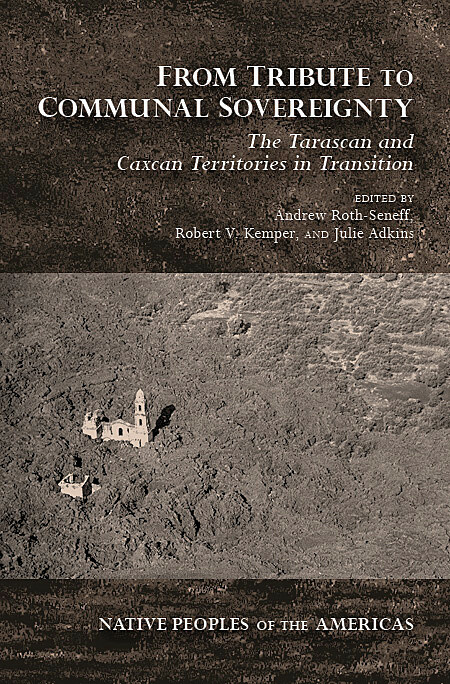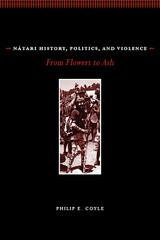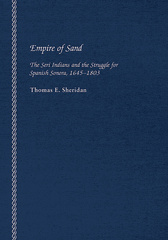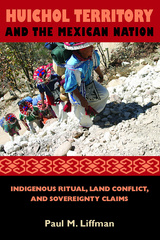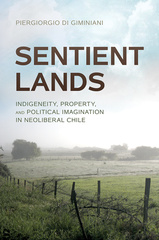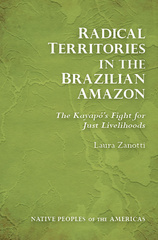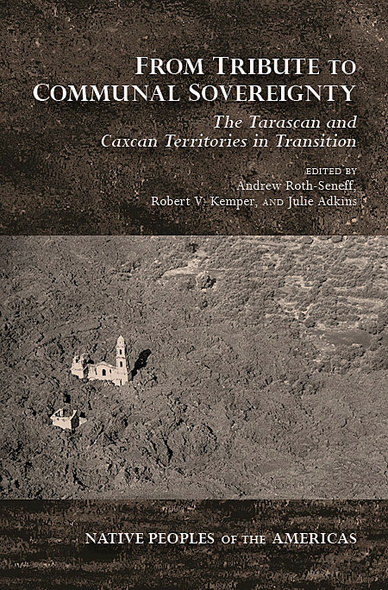
272 pages, 6 1/8 x 9 1/4
3 halftones, 16 line drawings, 15 tables
Hardcover
Release Date:11 Jun 2015
ISBN:9780816531585
From Tribute to Communal Sovereignty
The Tarascan and Caxcan Territories in Transition
SERIES:
The University of Arizona Press
From Tribute to Communal Sovereignty examines both continuity and change over the last five centuries for the indigenous peoples of central western Mexico, providing the first sweeping and comprehensive history of this important region in Mesoamerica.
The continuities elucidated concern ancestral territorial claims that date back centuries and reflect the stable geographic locations occupied by core populations of indigenous language–speakers in or near their pre-Columbian territories since the Postclassical period, from the thirteenth to late fifteenth centuries. A common theme of this volume is the strong cohesive forces present, not only in the colonial construction of Christian village communities in Purhépecha and Nahuatl groups in Michoacán but also in the demographically less inclusive Huichol (Wixarika), Cora, and Tepehuan groups, whose territories were more extensive.
The authors review a cluster of related themes: settlement patterns of the last five centuries in central western Mexico, language distribution, ritual representation of territoriality, processes of collective identity, and the forms of participation and resistance during different phases of Mexican state formation. From such research, the question arises: does the village community constitute a unique level of organization of the experience of the original peoples of central western Mexico? The chapters address this question in rich and complex ways by first focusing on the past configurations and changes in lifeways during the transition from pre-Columbian to Spanish rule in tributary empires, then examining the long-term postcolonial process of Mexican independence that introduced the emerging theme of the communal sovereignty.
The continuities elucidated concern ancestral territorial claims that date back centuries and reflect the stable geographic locations occupied by core populations of indigenous language–speakers in or near their pre-Columbian territories since the Postclassical period, from the thirteenth to late fifteenth centuries. A common theme of this volume is the strong cohesive forces present, not only in the colonial construction of Christian village communities in Purhépecha and Nahuatl groups in Michoacán but also in the demographically less inclusive Huichol (Wixarika), Cora, and Tepehuan groups, whose territories were more extensive.
The authors review a cluster of related themes: settlement patterns of the last five centuries in central western Mexico, language distribution, ritual representation of territoriality, processes of collective identity, and the forms of participation and resistance during different phases of Mexican state formation. From such research, the question arises: does the village community constitute a unique level of organization of the experience of the original peoples of central western Mexico? The chapters address this question in rich and complex ways by first focusing on the past configurations and changes in lifeways during the transition from pre-Columbian to Spanish rule in tributary empires, then examining the long-term postcolonial process of Mexican independence that introduced the emerging theme of the communal sovereignty.
Essential to understanding Spanish colonialism in North America.’—Economic Botany
‘Vitally important to archaeological, historical, and ethnographic analyses of West Mexico.’—Canadian Journal of Native Studies
‘The book is an important contribution to our understanding of Mesoamerican history in its full complexity. It recognizes the enduring significance of the pre-Hispanic Tarascan state and its ability to defend itself against Aztec and other central Mexican military domination, as well as the responses of indigenous people in the West Mexican area.’—Philip E. Coyle, author of Náyari History, Politics, and Violence: From Flowers to Ash
‘[This volume] is unique in its long-term historical perspective, connecting the pre-Columbian and colonial periods to the present. It brings together studies on a once-neglected area of Mexico and reveals its history by a masterful combination of archaeology, ethnohistory and ethnography.’—David Luke Robichaux, author of Familia y diversidad en América Latina: Estudios de caso
Andrew Roth-Seneff is a professor of anthropology at the Colegio de Michoacán and a member of the Mexican National System of Researchers. He is the editor of five books, most recently Caras y mascaras del México étnico: Vol. 1 y vol. 2. He serves as provost of the Colegio de Michoacán.
Robert V. Kemper (1945–2013) was a professor of anthropology at Southern Methodist University. For more than forty years, he carried out long-term research among the people of Tzintzuntzan, Michoacán, Mexico, where he worked on topics of migration and community transformation.
Julie Adkins is an instructor in anthropology at the University of Texas at Arlington. She is the co-editor of Not by Faith Alone: Social Services, Social Justice, and Faith-Based Organizations in the United States
Robert V. Kemper (1945–2013) was a professor of anthropology at Southern Methodist University. For more than forty years, he carried out long-term research among the people of Tzintzuntzan, Michoacán, Mexico, where he worked on topics of migration and community transformation.
Julie Adkins is an instructor in anthropology at the University of Texas at Arlington. She is the co-editor of Not by Faith Alone: Social Services, Social Justice, and Faith-Based Organizations in the United States
Acknowledgments
Part I Introduction
1 Ethnic Landscapes: Territoriality, Time Immemorial, and the Twenty-First Century
Andrew Roth-Seneff
2 Indigenous Population Transformations in West-Central Mexico
Robert V. Kemper and Julie Adkins
Part II Constructing the Historical Horizon of “Contact”
3 Territory and Resistance in West-Central Mexico, Part 1: Introduction and Archaeological Background
Phillip C. Weigand
4 Territory and Resistance in West-Central Mexico, Part 2: The Rebelión de Nueva Galicia and Its Late Postclassic Prelude
Phillip C. Weigand
5 The Prehispanic Heritage of the Tarascans (Purépecha)
Helen Perlstein Pollard
Part III Native Organization and Colonial State Formation
6 Visions of the Past: The Tarascan Kingdom and the Late Colonial Primordial Titles from Michoacán
Hans Roskamp
7 Identity and Ethnicity in Colonial Michoacán: Corporatism, Social Contract, and Individualism among the Tarascans
Felipe Castro Gutiérrez
8 Indigenous Space and Frontier in Sixteenth-Century Nueva Galicia
José Francisco Román Gutiérrez
Part IV The Past in the Present
9 The Historia of Islands: New Huichol Territorial Claims to Ancestral Places
Paul Liffman
10 The Defense of Territory in the Costa-Sierra Nahua of Michoacán
John Gledhill
11 Ritual and Public Spheres in an Ethnic Celebration of Communal Sovereignty: The Purépecha Transition
Andrew Roth-Seneff
References Cited
Editors and Contributors
Index

